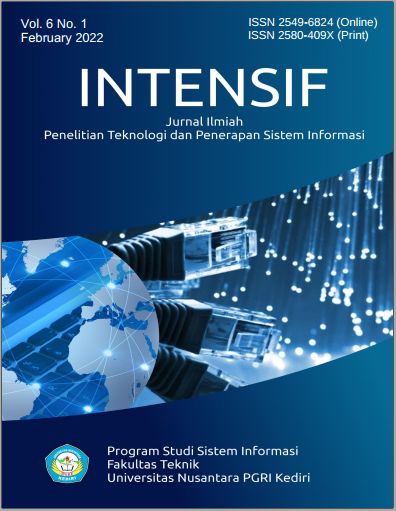Analysis of CART and Random Forest on Statistics Student Status at Universitas Terbuka
DOI:
https://doi.org/10.29407/intensif.v6i1.16156Keywords:
CART, Distance Learning, Ensemble, Machine Learning, Random ForestAbstract
CART and Random Forest are part of machine learning which is an essential part of the purpose of this research. CART is used to determine student status indicators, and Random Forest improves classification accuracy results. Based on the results of CART, three parameters can affect student status, namely the year of initial registration, number of rolls, and credits. Meanwhile, based on the classification accuracy results, RF can improve the accuracy performance on student status data with a difference in the percentage of CART by 1.44% in training data and testing data by 2.24%.
Downloads
References
S. Hasanah and S. Permatasari, “Metode Klasifikasi Jaringan Syaraf Tiruan Backpropagation Pada Mahasiswa Statistika Universitas Terbuka,” vol. 14, no. 2, pp. 243–252, 2020, doi: 10.30598/barekengvol14iss2pp249-258.
S. H. Hasanah, "Multivariate Adaptive Regression Splines ( MARS ) for Modeling The Student Status at Universitas Terbuka," vol. 7, no. 1, pp. 51–58, 2021, doi: https://doi.org/10.15642/mantik.2021.7.1.51-58.
C. D. Sutton, "Classification and Regression Trees, Bagging, and Boosting," Handb. Stat., vol. 24, no. 04, pp. 303–329, 2005, doi: 10.1016/S0169-7161(04)24011-1.
R. Maclin, "Popular Ensemble Methods : An Empirical Study Popular Ensemble Methods : An Empirical Study," J. Artif. Intell. Res., vol. 11, no. July, pp. 169–198, 2016.
M. van Wezel and R. Potharst, "Improved customer choice predictions using ensemble methods," Eur. J. Oper. Res., vol. 181, no. 1, pp. 436–452, 2007, doi: 10.1016/j.ejor.2006.05.029.
L. Breiman, "Bagging predictors," Mach. Learn., vol. 24, no. 2, pp. 123–140, 1996, doi: 10.1007/bf00058655.
H. Inoue and R. Inoue, "A very large platform for floating offshore facilities," Coast. Ocean Sp. Util. III. Proc. Symp. Genoa, 1993, pp. 533–551, 1995.
R. E. Schapire, "Explaining adaboost," Empir. Inference Festschrift Honor Vladimir N. Vapnik, pp. 37–52, 2013, doi: 10.1007/978-3-642-41136-6_5.
L. Breiman, "Random forests," Mach. Learn., vol. 45, no. 1, pp. 5–32, 2001, doi: 10.1023/A:1010933404324.
A. Davies and Z. Ghahramani, "The Random Forest Kernel and other kernels for big data from random partitions," 2014, [Online]. Available: http://arxiv.org/abs/1402.4293.
R. Srivastava, A. N. Tiwari, and V. K. Giri, "Solar radiation forecasting using MARS, CART, M5, and random forest model: A case study for India," Heliyon, vol. 5, no. 10, p. e02692, 2019, doi: 10.1016/j.heliyon.2019.e02692.
E. A. Antipov and E. B. Pokryshevskaya, "Mass appraisal of residential apartments: An application of Random forest for valuation and a CART-based approach for model diagnostics," Expert Syst. Appl., vol. 39, no. 2, pp. 1772–1778, 2012, doi: 10.1016/j.eswa.2011.08.077.
J. Yu et al., "Ship arrival prediction and its value on daily container terminal operation," Ocean Eng., vol. 157, no. January, pp. 73–86, 2018, doi: 10.1016/j.oceaneng.2018.03.038.
R. Chairunisa, “Perbandingan CART dan Random Forest untuk Deteksi Kanker berbasis Klasifikasi Data Microarray,” vol. 1, no. 1, pp. 19–25, 2017.
N. Z. Zacharis, "Classification and regression trees (CART) for predictive modeling in blended learning," Int. J. Intell. Syst. Appl., vol. 10, no. 3, pp. 1–9, 2018, doi: 10.5815/ijisa.2018.03.01.
A. Hartati, I. Zain, and S. Suprih, “Kepala Rumah Tangga di Jawa Timur,” J. Sains Dan Seni Its, vol. 1, no. 1, pp. 101–105, 2012.
V. Y. Kullarni and P. K. Sinha, "Random Forest Classifier: A Survey and Future Research Directions," Int. J. Adv. Comput., vol. 36, no. 1, pp. 1144–1156, 2013.
Downloads
Published
Issue
Section
License
Authors who publish with this journal agree to the following terms:
- Copyright on any article is retained by the author(s).
- The author grants the journal, the right of first publication with the work simultaneously licensed under a Creative Commons Attribution License that allows others to share the work with an acknowledgment of the work’s authorship and initial publication in this journal.
- Authors are able to enter into separate, additional contractual arrangements for the non-exclusive distribution of the journal’s published version of the work (e.g., post it to an institutional repository or publish it in a book), with an acknowledgment of its initial publication in this journal.
- Authors are permitted and encouraged to post their work online (e.g., in institutional repositories or on their website) prior to and during the submission process, as it can lead to productive exchanges, as well as earlier and greater citation of published work.
- The article and any associated published material is distributed under the Creative Commons Attribution-ShareAlike 4.0 International License












